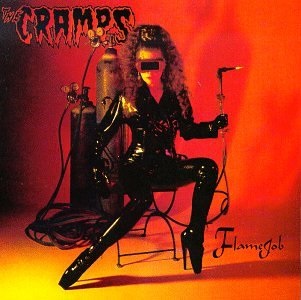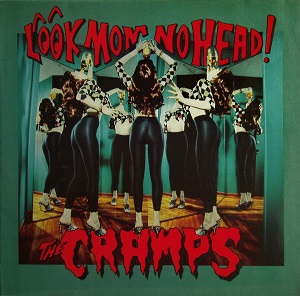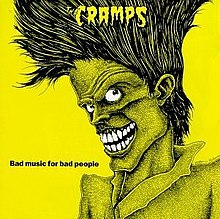
From slugmag.com
The American rock band the Cramps, who blazed a sonic trail for three memorable decades from the mid-1970s to the mid-noughties, wore an awful lot of influences on their black-leather sleeves. Yet somehow they managed to meld those influences into a sound and style quite unlike anyone or anything else.
They took as inspiration classic 1950s rock ‘n’ roll, rockabilly, surf music, garage rock, the velocity and bad attitude of punk and the darkness and glamour (but not the pomposity) of goth. The band’s heart and soul were guitarist Poison Ivy (Kirsty Wallace), who was responsible for their sometimes juddering, sometimes twangy, always captivating guitar sound and who wasn’t adverse to posing for album-cover photos in high heels, fishnets, suspenders, shades, devil’s horns and body-hugging PVC; and her romantic and musical partner, the towering vocalist Lux Interior (Erik Purkhiser), whose sepulchral voice and ghoulish lyrics channelled a 1950s American childhood spent immersed in trashy horror, sci-fi and exploitation movies and gruesome sensationalist comics like Vault of Horror and Tales from the Crypt.
Outside the creative nucleus of Ivy and Lux, the Cramps underwent a lot of line-up changes. Among some 20 band-members over the years, only guitarists Bryan Gregory and Kid Congo Powers, bassists Candy Del Mar and Slim Chance and drummers Nick Knox and Harry Drumdini were around long enough to make much impression.
Under Ivy and Lux’s control, the Cramps became a Frankenstein’s Monster fashioned out of pieces of Elvis, Ricky Nelson, Link Wray, Dick Dale, Screamin’ Jay Hawkins, the New York Dolls, the Ramones, Roger Corman, Ed Wood, Herschell Gordon Lewis, the Marquis de Sade and the Addams Family; but this was no lumbering misshapen monster. This was something cadaverously elegant and it rocked.
As usual, I was late to the party. I didn’t get into the Cramps until the late 1980s, a dozen years after they’d started, thanks to my brother giving me a crackly cassette-tape recording of their 1983 compilation album Off the Bone. Incidentally, on the other side of the cassette was the 1988 Sugarcubes album Life’s Too Good. Wow, those were the days.

© Creation
But at least by then I’d heard of the Cramps. Indeed, the band had been credited with inventing their own musical genre, psychobilly. Their supposed progeny, such raucous, upright-bass-slapping combos as the Meteors, Guano Batz and King Kurt, with their thickly greased quiffs, brothel creepers and copious tattoos, had been rampaging through the sweatier, dingier music venues of 1980s Britain. The music journalist Dick Porter notes in his 2015 biography of the band Journey to the Centre of the Cramps that the Cramps were certainly responsible for the term ‘psychobilly’. They’d made the word up and stuck it on a promotional flyer when they were trying to get themselves noticed in New York a decade earlier. But they maintained a polite and slightly bemused distance from the actual musical scene they were meant to have spawned.
Porter quotes Poison Ivy as saying, “I think our songs have a more sensuous tempo. I’m not sure what exactly defines psychobilly but it seems to have taken on a life of its own. But it’s not quite what we do.” Porter himself observes that “whereas the Cramps drew on a smorgasbord of influences that included R&B and doo-wop, the psychobilly groups tended to eschew blues-based influences and splice rockabilly to a punk template that hadn’t existed back when the Cramps got started.”
Anyway, as soon as I heard Off the Bone, I was hooked. And I snapped up their releases in subsequent years, albums like Stay Sick (1990), Look Mom No Head (1991) and Flamejob (1994), which were choc-a-bloc with irresistible songs like Bikini Girls with Machine Guns, Creature from the Black Leather Lagoon, Journey to the Centre of a Girl, All Women are Bad, I Wanna Get in your Pants, Eyeball in my Martini, Bend Over I’ll Drive, Let’s Get F***ed Up and Naked Girl Falling Down the Stairs. Even now, when I’m feeling a little down or stressed about something, I only have to listen to one of those songs, with the stutter or buzz of Poison Ivy’s guitar, and with Lux Interior’s macabre, funny and innuendo-laden lyrics, and after a minute I’ll feel right as rain again.

© Restless / Enigma
Take Naked Girl Falling Down the Stairs, for instance: “I fell in love at a terrible pace… When someone gave her a shove down a staircase…” I mean, how can anyone not love a song called Naked Girl Falling Down the Stairs?
I never saw them live, though, which is something I really regret now.
One thing the band never received enough praise for was their musicianship. There’s a perception of the Cramps, popular for example among certain snooty British music critics, as a kitschy, campy and not-to-be-taken-seriously novelty act. This overlooks the skill, attention to detail and sheer hard graft that went into composing and recording their songs. Ivy and Lux were extremely knowledgeable about their influences and committed about what they did and they put the work in. Their finished songs might’ve made it look and sound easy, but this illusion of effortlessness is testimony to high standards of talent and professionalism behind the scenes.
The story of the Cramps ended on a melancholic note, for in 2009 Lux Interior died suddenly and unexpectedly from a tear in his aortic wall. Not only did his death deprive rock ‘n’ roll music of one of its most striking and amusing figures; but it also brought the curtain down both on his lifelong romantic and creative partnership with Poison Ivy and on the Cramps themselves.
That partnership and the band were of course one and the same thing. As Poison Ivy remarked to Dick Porter in 2006, “That’s all the Cramps is – a folie à deux.”

© I.R.S
